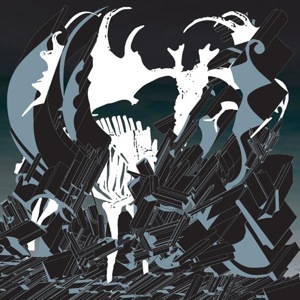In Norse mythology, Jörmungandr, also known as the Midgard (World) Serpent, is a sea serpent, the middle child of the giantess Angrboða and Loki. According to the Prose Edda, Odin took Loki's three children by Angrboða—the wolf Fenrir, Hel, and Jörmungandr—and tossed Jörmungandr into the great ocean that encircles Midgard. The serpent grew so large that it was able to surround the Earth and grasp its own tail. As a result, it received the name of World Serpent. When it releases its tail, Ragnarök will begin. Jörmungandr's arch-enemy is the thunder-god, Thor. It is an example of an ouroboros.

The ouroboros or uroboros is an ancient symbol depicting a serpent or dragon eating its own tail. Originating in ancient Egyptian iconography, the ouroboros entered western tradition via Greek magical tradition and was adopted as a symbol in Gnosticism and Hermeticism and most notably in alchemy. The term derives from Ancient Greek οὐροβόρος, from οὐρά oura 'tail' plus -βορός -boros '-eating'. The ouroboros is often interpreted as a symbol for eternal cyclic renewal or a cycle of life, death, and rebirth. The skin-sloughing process of snakes symbolizes the transmigration of souls, the snake biting its own tail is a fertility symbol in some religions, and the tail of the snake is a phallic symbol, the mouth is a yonic or womb-like symbol.
Ouroboros is an ancient symbol depicting a snake or dragon swallowing its tail.
Soleilmoon Recordings is an American record label that began in 1987 as a cassette label, operating from the back of a record shop called the Ooze in Portland, Oregon, US.

Sun Baked Snow Cave is a collaborative album between Japanese experimental doom band Boris and Japanese noise musician Merzbow. The album consists of a single track that clocks in at over an hour in length. The album artwork was done by Sunn O))) member and regular Hydra Head designer Stephen O'Malley.

This is a comprehensive discography of the Japanese noise musician Masami Akita, best known for his project Merzbow. Since 1980 he has released hundreds of recordings, collaborated with dozens of musicians, contributed over two hundred exclusive tracks to compilations, and made numerous guest appearances on recordings by other artists.

Minazo Vol. 1 is an album by Japanese noise musician Merzbow. It was followed by Minazo Volume Two released on vinyl.

Merzbeat is a studio album by the Japanese noise musician Merzbow. It features beats sampled from rock, just like 1998's Aqua Necromancer. However, the beats are more prominent and the noise is simpler than earlier albums. "Promotion Man" samples the song of the same name and "I'll Do It All Again" by the 1970s hard rock band Highway Robbery. This is the first album to feature Minazo on the cover along with the reproduction of Azuchi Castle.

Senmaida is a studio album by the Japanese noise musician Merzbow. It is named for Senmaida, a scenic rice terrace in Wajima, Ishikawa. A photo of Senmaida appears on the interior of the sleeve. The album was recorded at the same time as Houjoue and Merzbuta. The first few pre-orders from the label included a Senmaida postcard.

Hole is an album by the Japanese noise musician Merzbow. It is a limited edition of 500 copies, 200 of which were only available for sale in Japan. 50 copies only available through Soleilmoon mailorder, and included an additional card and came wrapped in paper.

Merzbow is a Japanese noise project started in 1979 by Masami Akita. Merzbow is best known for a style of harsh, confrontational noise. Since 1980, Akita has released over 400 recordings and has collaborated with various artists.

13 Japanese Birds is a 15 album series by the Japanese noise musician Merzbow. It was inspired by Olivier Messiaen's Catalogue d'oiseaux, but has no direct musical relationship.

Eucalypse is an album by the Japanese noise musician Merzbow. The title is a combination of apocalypse and eucalyptus.

Hiranya is an album by Japanese noise musician Merzbow. The album was originally supposed to be released for Merzbow's appearance on May 17 at No Fun Fest in New York City, but Masami Akita cancelled his tour due to travel restrictions caused by the swine flu outbreak. The album art parodies that of Aqualung by Jethro Tull, with the human figures replaced with birds. The artwork of Graft was also inspired by a Jethro Tull record.

Graft is an album by the Japanese noise musician Merzbow. The recording was inspired by the plant illustrations in the Voynich manuscript, and the design was inspired by a 1970s Jethro Tull bootleg called My God. The artwork for Hiranya was also inspired by a Jethro Tull album.

Merzbient is a boxed set album by the Japanese noise musician Merzbow, it is composed of previously unreleased raw material recorded 1987–90.

Samidara is an album by the Japanese noise musician Merzbow, released as both an LP and a cassette. It was made available for pre-order on December 5, 2012, but didn't start shipping until July 2013.

Takahe Collage is an album by the Japanese noise musician Merzbow. The album is named after the native New Zealand takahē bird.

Tamayodo is an album by the Japanese noise musician Merzbow. It is described as "monotonic electro pulse-noise works by all analogue equipments."

Cuts is collaborative studio album by the Japanese noise musician Merzbow, Hungarian drummer Balázs Pándi, and Swedish saxophonist Mats Gustafsson. It was recorded during a stop on the trio's East European tour in April 2012. The album was followed up in January 2015 by Live in Tabačka 13/04/12, which was recorded live the day before Cuts in Slovakia. Cuts of Guilt, Cuts Deeper, a studio album recorded with the addition of Thurston Moore, was released in March 2015.

















